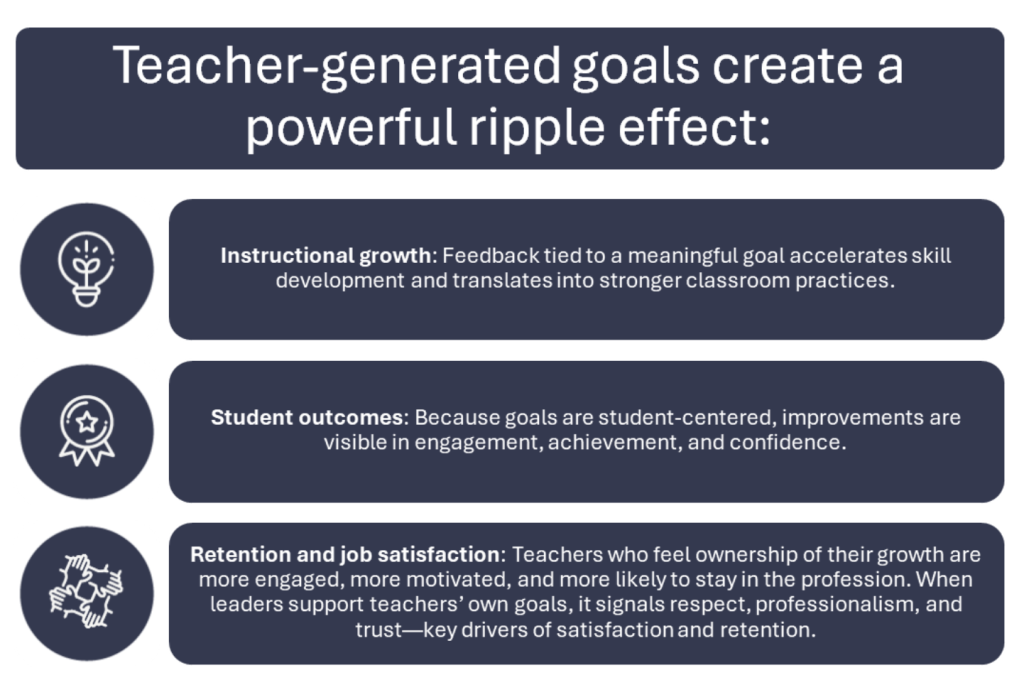As the school year kicks into gear, school leaders are beginning their classroom walk-throughs to check in on progress for student learning and campus initiatives. As school leaders, one of the most powerful ways we can influence student outcomes is by anchoring coaching conversations in the goals teachers set for themselves. Let’s take a look at how to start strong with the Texas Teacher Evaluation and Support System (T-TESS) and teacher goals.
Harnessing Teacher-Generated Goals for Highly Impactful Instructional Feedback
As part of the evaluation process in Texas, teachers are required to set two goals each year—one for their professional practice and student growth. They are also required to meet with their appraiser to review the goals, determine criteria for success, and develop action steps to improve in this area.
Teacher Goal-Setting and Professional Development (GSPD) plans should not be a compliance exercise. An effective and practical principal understands that they are the roadmap for improving instruction, deepening teacher practice, and strengthening student learning.
The T-TESS reinforces that coaching is most effective when feedback aligns with high-quality, teacher-generated goals. Research from Jim Knight’s Instructional Coaching Group and Corwin reinforces this: when teachers own their goals, they are more motivated, the goals are more relevant, and the coaching that follows is far more impactful. When all these factors are at play, we yield higher levels of student success.
Guiding Teachers to Write High Quality Goals
One of the first pieces of the T-TESS evaluation process begins with teacher goal-setting. This is an opportunity for the teacher to reflect on the data to evaluate their practice and how it impacted student outcomes in the past. Once they reflect on this data, they can set a goal that is student-centered and will impact meaningful change in their practice. As a practical principal, you might need to help your teachers refine their goals to ensure clarity, actionability, and relevance based on data and campus or district goals.
A strong goal is:
- Based on Evidence: rooted in student work, classroom observation, or data.
- Student-Centered: focused on what students will know, do, or produce as a result of instructional shifts.
- Meaningful and Aligned: Starting with campus or district goals, teachers reflect on what work they can do to support that momentum chosen by the teacher, tied to what they care about most in their practice.
- Just Right: specific and measurable without being overwhelming or too narrow.
What If the Goals the Teacher Writes Need to Be Stronger?
As you are meeting with teachers to review their GSPD plan, you may notice that some need a little support in generating stronger goal statements. Using the questions below, leaders can support teachers in refining their goals and plans for success by asking the following:
- Goal is not based on evidence: “Reflecting on last year’s student data and observations about your students, what evidence did you use to guide your professional growth goal?”
- Goal is not student-centered: “What would students be doing differently if you reached this goal? On a scale of 1–10, where are you now, and what would move you one point higher?”
- Goal is vague: “What are the specific actions we will see you or the students doing or saying if this goal is reached? What specific indicators or outcomes will show successful attainment of this goal?”
- Goal plan does not identify strategies or clear next steps: “What are the first few steps or strategies that you will work toward to put this goal into practice?”
- Other considerations to align feedback: “As I visit your classroom and provide feedback on this goal, what kind of feedback or evidence would be most helpful for you to track your progress toward the goal?”
When leaders and teachers co-create goals in this way, they ensure that coaching conversations are precise, consistent, and motivating.
Examples of Teacher Goals
Let’s look at an example. The principal at Happy Student Middle School shared a goal set by the site-based decision-making team to improve student learning for Tier 1 instruction. Their CIP goal is “by May 2026, 100% of classroom teachers will implement strategies to meet the needs of all learners during Tier 1 instruction to address student misconceptions, disengagement, and readiness needs in real time.”
Reviewing Goals
The principal has shared this goal with their teachers, in order for teachers to reflect on their own practice and determine a professional growth goal that will support this work. Ms. Smith has written a goal, but it needs some refining. She wrote:
“I will implement strategies to make my Tier 1 instruction better, so my students are more successful on the exit ticket.” The challenge with this goal statement is that it is vague and lacks evidence. The goal does have a focus on student outcomes, but lacks clarity on a specific focus to improve their instructional practice. As the teacher and school leader reflect on the goals, they might refine them to one of the following options.
Reflecting and Refining Goals
| Goal Statement | Criteria for Success/Evidence | Possible Strategies & Actions |
|---|---|---|
| By mid-semester, I will increase the frequency and clarity of checks for understanding during each lesson to better identify student misunderstandings and adjust instruction accordingly. | Planning Look For: At least three discrete checks for understanding in every lesson (e.g., exit tickets, cold-calls, whiteboard responses). Walk-through Look For: In 80% of walk-throughs, the teacher modifies the next part of the lesson when student responses indicate misunderstanding. | Use formative assessments (exit tickets or quick writes), plan pauses built into the lesson for checking understanding. Use walk-through feedback to notice when adjustments were/were not made. Analyze student work immediately after class to plan the next day’s instruction. |
| By the end of the semester, I will use real-time student behavior and engagement cues (body language, discussion participation, facial expressions) to adjust activities or pacing in every class at least once per week to maintain engagement. | Planning Look For: At least once per week, prepare an alternate activity plan when disengagement might be likely (e.g., a change of pace, switching from independent work to partner talk, mini-break, etc.). Walkthrough Look For: Student engagement metrics improve by 15% (e.g., participation rate, on-task behavior). Other data: Fewer students report boredom or confusion on periodic student surveys. | Training to notice cues of disengagement Build alternative activity plans (Lead4Ward Instructional Strategies Playlist, AVID, Kagan Strategies). Plan for flexible grouping and transitions. Incorporate interactive or collaborative elements, use exit surveys or quick reflections. |
But Why Does It Matter?
Coaching isn’t about telling teachers what to do—it’s about partnering with them to achieve the goals they care most about and supporting them in identifying goals that will support campus and student success initiatives.
When school leaders consistently tie coaching feedback to teacher-established goals, they build a culture of growth and empowerment that strengthens instruction, gives staff agency, and improves student outcomes.

Check out this month’s freebie to help you document your teachers’ goals, connect the goals to a T-TESS dimension to focus on, and track the feedback and work they’re doing to meet those goals. Starting strong with the T-TESS helps you and your staff get and stay on track.
T-TESS Dimension Tracker
Download and use our Excel spreadsheet for principals to track the T-TESS dimension for the goal and track their walk-through feedback.
Natalie is an Educator Evaluation and Leadership Administrative Specialist at ESC Region 13.






Add comment